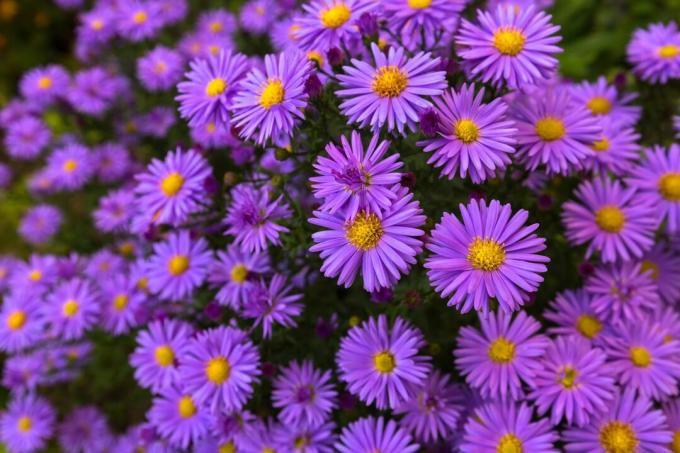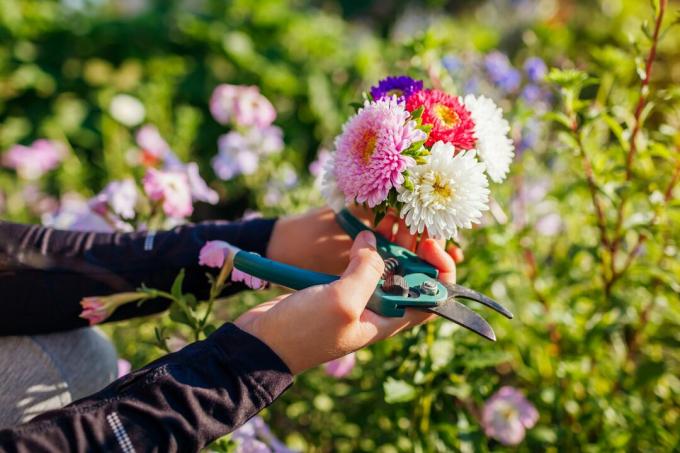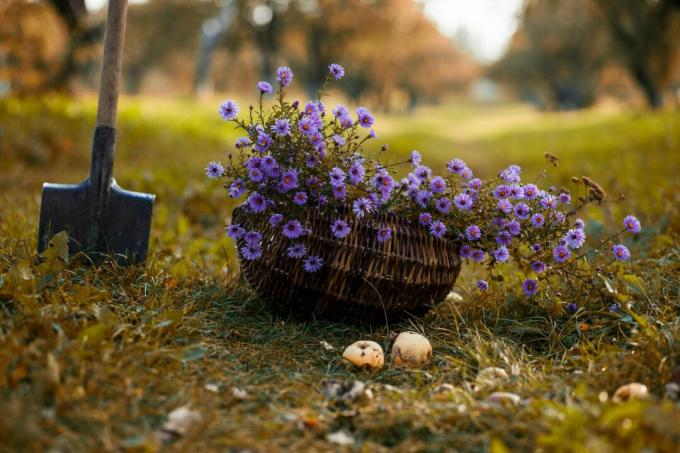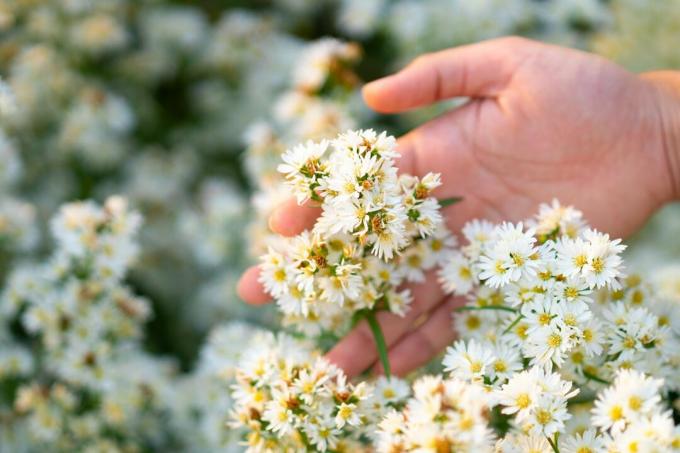Asters are flowers that look great in any garden or park. The countless species and varieties can decorate the garden with their flowers from May to November.

The late-blooming smooth-leaf aster (Symphyotrichum novi-belgii), the flat growing pillow asters (Aster dumosus) or the brightly colored Raublatt aster (Symphyotrichum novae-angliae) have been inspiring us in gardens for year and day with their flowers. The care of the aster is also not very complicated, which is one of the reasons for its triumph in the use of perennials. You can learn more about the handling of this excellent group of garden perennials in this article.
contents
- Asters: origin and characteristics
- Planting asters: location, planting time and Co.
-
Proper care
- Watering and fertilizing
- Cut asters
- Pests and diseases
- Which asters are hardy?
- Multiplication
- Are asters poisonous?
Asters: origin and characteristics
The asters belong to the sunflower family (
Asteraceae), which gave the plant genus its name. The plants, formerly also called star flowers, originally come from America, Africa, but also Eurasia.Tip: After a reorganization of the botanical system within the sunflower family, species such as the smooth-leaf aster and the Raubl-leaf aster no longer belong to the genus aster, are colloquially called asters. There are also many other composites that are also referred to as such because of their great resemblance to asters. You can find out more about this in the article on the types and varieties of asters.
Since the herbaceous plants have a great diversity of species, the spectrum of appearance is very broad. The height can vary from a few centimeters to 3 meters. The leaves of the asters can be either basal or alternate, stalked or sessile on the stem. But the structure of the flowers is quite uniform for all aster species and varieties. The cup-shaped flowers consist of a wreath of white, pink, violet or blue-colored ray-flowers, in the center of which are the yellow tubular flowers.

How long do asters bloom? The flowering time of asters also varies depending on the species or variety:
- Spring asters: flowering time in May
- Summer asters: flowering from July to August
- Autumn asters: flowering period September - October
- Winter asters: flowering period October - November
The group of asters is particularly valuable for bees due to the wide flowering period that can result from planting different types of asters. The late-blooming asters in particular are an important source of food for the insects when there are hardly any other flowers.
Are asters annual or perennial? Most of the asters are perennial. The annual summer asters (Callistephus chinensis) are actually annual, but actually do not belong to the genus aster.

Planting asters: location, planting time and Co.
The location of the aster should be sunny and have loose, well-drained soil with medium nutrient content. But there are also species that tolerate partial shade well.
The best time to plant an aster is from March to May or September to November. When planting, it is important not to put the perennial deeper into the ground than it was in the pot. Small species like the pillow aster can be planted about 25 cm apart, medium-sized species 45 cm apart, and large specimens 50 to 60 cm apart.
sowing: From mid-May onwards, it can be sown broadly in a good location in the field and, after germination, isolated to the species-specific distance. With the pre-culture in the house, the seeds can be placed 1 cm deep in the sowing soil as early as February. The substrate should then be kept moist and the germination temperature should be around 15 ° C. It can take more than four months for the plants to be vigorous enough to be planted outdoors.
If the asters are cultivated in pots, which is only possible with a few species such as the small predatory aster, a regular supply of water and nutrients should be considered. Use a well-drained, structurally stable soil without mineral fertilizers. Our Plantura organic potting soil For example, it is particularly suitable for planting thanks to long-term organic fertilization, as asters are sensitive to excessive nutrient concentrations. The broken expanded clay in the earth also ensures high structural stability.
Proper care
Caring for the asters outdoors and in pots includes pruning in March, occasional fertilization and moderate watering.

Watering and fertilizing
For asters in pots, fertilizer should be fertilized about every two weeks from April to August. It is advisable to use an organic-mineral fertilizer to meet the nutritional needs of the perennials. For example, our Plantura organic flower fertilizer can be used, which is mixed in when potting and practically only needs to be used once or twice a year. This slow release fertilizer can also be used in spring for the asters in the field.
The plants should be given a good supply of water, especially when they are developing, as the flowers can otherwise be sparse. If the drought lasts for a long time, your garden asters should be watered regularly outdoors. The substrate in the pots should be kept moderately moist and should neither dry out nor wet.
Wilted flowers can be cleaned constantly to encourage further flower growth. It is also recommended to divide the plant every two to three years in order to keep the asters vital. This works best with individually growing plants that can also be grown in pots, such as the pillow aster. When dividing the perennial, the old substrate can also be replaced by a new one in the case of potted cultivation.

Cut asters
Apart from regular cleaning during the flowering period, around the end of the winter period in March, the asters are pruned close to the ground to allow the plants to sprout again promotes. The withered parts of the plant still offer protection over the winter. To prevent self-sowing, the upper third can be shortened after flowering.
Are hardy asters pruned? Even hardy asters should only be cut back in spring to protect the root ball from low temperatures.

Pests and diseases
The most common diseases are aster wilt and powdery mildew. The asters wilt show up through brownish discoloration of the foliage and slack leaves. This should be avoided from the outset by buying resistant varieties. You can find out about recommended varieties, for example, on the website of the Perennial Sighting Working Group or in the course of a consultation in the perennial nursery. Powdery mildew infestation can also be kept within limits by robust varieties, but unfortunately not always. Spraying with one Stock made from field horsetail can also provide a remedy here. More about the powdery mildew and downy mildew and how to combat it, you can read about in our article.

Which asters are hardy?
Except for the annual summer asters, all asters are hardy. In order to still offer them additional protection, the ground in the open field can be covered with leaves, brushwood or fir branches. The asters in pot culture should be placed against a protected house wall and the pot should be wrapped with fleece to protect the root ball. The occasional moistening of the soil should not be forgotten here, otherwise the plants will die from drying out.
Multiplication
The perennial asters can easily be multiplied by division, which should be done every few years in spring or autumn, if the type of planting allows it. The root runners of the mother plant can be pricked out of the earth with a spade and divided as required. These are then replanted in a new, sunny location. Another, albeit rather difficult, method of propagating perennial asters is via basal shoot cuttings.
Annual asters, such as summer asters, can be propagated from seeds. After the seeds have bloomed and ripened, they can be harvested and either pulled forward on the windowsill in spring or sown outdoors from mid-May.

Are asters poisonous?
The flowers of the well-known garden asters are edible, i.e. non-toxic for humans, and they also pose no danger to animals. However, since the variety of species and varieties of asters is so great and they could perhaps be confused with chrysanthemums, which are poisonous, you should really only consider consumption if you can reliably identify the genus and species and rule out any intolerance can.

If you want to offer the insects in your garden even more sources of food in autumn or if you want to benefit from blooming flowers yourself, then it is worthwhile to find more Autumn flowers to plant. In our article we introduce you to the ten most beautiful ones for your garden.
